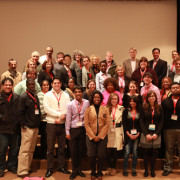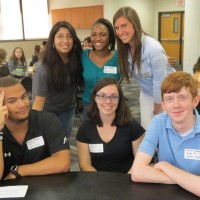Byrd Emphasizes Value of Visualization at XSEDE14
By: Trish Baker
 Visualization expert Dr. Vetria Byrd closed out the XSEDE14 conference in Atlanta with a passionate talk about the value of visualization across all areas of research and scholarship, as well as a snapshot of some of her recent effort to bring more people into the visualization fold.
Visualization expert Dr. Vetria Byrd closed out the XSEDE14 conference in Atlanta with a passionate talk about the value of visualization across all areas of research and scholarship, as well as a snapshot of some of her recent effort to bring more people into the visualization fold.
Dr. Byrd, the director of advanced visualization at Clemson University, emphasized that visualizing data is about much more than producing pretty pictures. “The pretty pictures are the icing on the cake,” she said. “I consider myself an agent for insight. My mission is to enable researchers to gain keen insight into their data by equipping them with tools and resources that will allow for visualizing the expected, and discovering the unexpected in their data.”
The need for and significance of visualization are common across all disciplines, Dr. Byrd said. “Visualization is fundamental in understanding data from all aspects of research and scholarship. Regardless of what your field is, there will be a need to visualize your data.”
Because of that widespread necessity for visualization skills, Dr. Byrd believes it is imperative to diversify the field. To that end, she detailed to recent efforts she led: the two-day workshop 1st CRA-W/CDC Broadening Participation in Visualization Workshop supported by the Committee on the Status of Women in Computing Research (CRA-W) and the Coalition to Diversify Computing (CDC), and a National Science Foundation Research Experiences for Undergraduates (REU) site in Collaborative Data Visualization Applications, both at Clemson.
Dr. Byrd met her ambitious goal of recruiting more than 100 applicants for the February 2014 BPViz workshop, which was diverse in participant and speaker background, research topics, and representation of disciplines. Forty-four percent of participants were women; some were high school and undergraduate students, while others were post-docs; many were from academia, but some were also from industry, and at least one was an artist.
In an example of how visualization can be a “catalyst for communication,” Dr. Byrd encouraged workshop participants to “think of visualization as an ice breaker, or as a communication tool” as they presented their posters. “The very participants who were reluctant to present a poster declared (the poster session) the best part of the workshop.”
Dr. Byrd also views visualization as “a conduit for collaboration,” which is exemplified by the visualization REU site she leads. The REU site involves 10 students and 10 research faculty from a wide range of disciplines, including digital humanities, anthropology, education, and chemistry.
“The focus of this REU is to give the students the opportunity to have the research experience, and also to give the researchers the opportunity to move their research forward. My students are actually working to understand what visualization is, not just for themselves, but for the researcher they are working with,” she said. “By having these students on campus, it gives the faculty an opportunity to understand the visualization process, and encourages them to think about visualization at the beginning of their research process.”
In conclusion, Dr. Byrd asked the audience: “Why should you care about visualization?” She answered her own question: “Visualization is a key part of what we do. It’s a key part of enabling us to convey the research we’re doing to others. I am doing my part to letting people know that visualization is key to understanding their research.”
REU Site funded by NSF ACI Award No. 1359223. Broadening Participation Workshop partially funded by NSF ACI Award No. 1419415.






